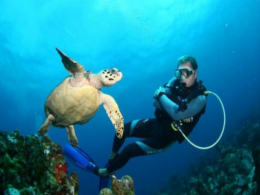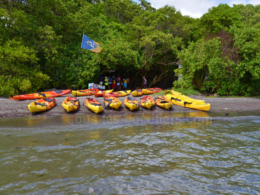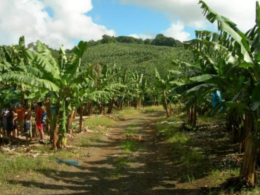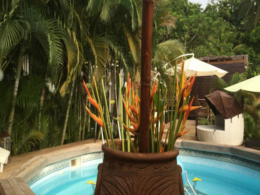Martinique, a rugged Caribbean island that’s part of the Lesser Antilles and an overseas region of France, reflects a distinctive blend of French and West Indian cultures. Like Guadeloupe, it is an overseas region of France, consisting of a single overseas department. One of the Windward Islands, it is directly north of Saint Lucia, northwest of Barbados, and south of Dominica.
Martinique is one of the eighteen regions of France (being an overseas region) and an integral part of the French Republic. As part of France, Martinique is part of the European Union, and its currency is the euro. The official language is French, and virtually the entire population also speak Antillean Creole (Créole Martiniquais).
Population: 386,486(2013)
Area: 436 mi²
Capital: Fort-de-France
Languages: French
Currency
The local currency is Euros but U.S. dollars, traveler's checks and major credit cards are widely accepted.
Climate
The climate is tropical as in the Caribbean islands but Martinique is divided into two different areas. South is dry and north is greener with rain forest and mountains. The weather is hot and sunny with as “colder” and rainier season from June to September. Average temperature: 25°c
Safety
Because Martinique attracts the wealthy and famous, it also attracts pickpockets. Luckily, petty theft is about the only crime you’ll have to worry about. Violent crimes are infrequent as there is a reliable police force patrolling the island. Pickpocketing, too, can be avoided if you are smart about how you carry yourself. Don’t obviously display expensive electronics or cell phones, and never rifle through money in public. Keep your purse or bag close at all times and take advantage of your hotel safe rather than carry valuables with you.
The only other safety issue of note in Martinique is hurricanes. The United States, among other countries, has begun recommending that international travelers register with the government, in order to better account for citizens in the event of a natural disaster. If you are visiting during hurricane season (summer and fall) this is a smart idea.
Health
As in much of the Caribbean, dengue fever has made an unwelcome reappearance in Martinique. Dengue is transmitted by mosquito bites, so wear long sleeves and cover your legs in the evenings, and sleep under a mosquito net. Consult a doctor immediately if you experience fever, exhaustion or extreme fatigue.
There is also a risk of bilharzia (schistosomiasis) infection throughout the island; the main precaution is to avoid wading or swimming in fresh water.
The fer-de-lance, an aggressive pit viper, resides on Martinique. The snake’s bite is highly toxic and sometimes fatal so it’s essential for victims to get an antivenin injection as soon as possible. They favor overgrown and brushy fields, so hikers should be alert for the snakes and stick to established trails.
Beware of manchineel trees found on some beaches, particularly on the south coast, as rainwater dripping off them can cause skin rashes and blistering. They’re usually marked with a band of red paint.
Tap water is safe to drink in Martinique.
Transportation
Public transport in Martinique is very limited, which could explain the reason why there are more cars registered in Martinique per person than anywhere else in France.
Despite the traffic, if you are going to make the most of your stay in Martinique, it is recommended that you hire a car. Without a car you will miss some of Martinique's best landscapes and scenery.
Due to the Taxi Union demands, there is no public transport from the airport, which means that you can either hire a car or take a taxi.
Buses There are very few buses in Martinique. Most bus services are mini buses marked "TC", which stands for "Taxi Collectifs". The destinations of the buses are marked on a board either on the front window or on the side door. Bus stops (arret autobus) are normally a square blue sign with a picture of a bus in white.
There are shuttle boats every 30mins from Pointe du Bout and Trois Ilet to Fort-de-France. It is a very pleasant way of getting to Fort-de-France and also avoids the traffic. Services finish between 5:45 and 8PM depending upon the day.
Hitchhiking is very common in Martinique, although like anywhere in the world not recommended. If you are going to hitchhike, take lots of water and try to stay out of the sun. There are very few footpaths in Martinique, so be careful and take the usual precautions that you have to take when hitchhiking anywhere. If you are unsure about getting into a car, just keep walking or wait for another car.
Driving in Martinique will be a pleasure in comparison to other Caribbean islands. The majority of roads are of an excellent standard. Your driving license from your home country is valid in Martinique. Driving laws are the same as in France and you have to drive on the right hand side of the road. Distances and speed limits are in Km and Km/h. There are several speed cameras on the island and the Gendarmerie are carrying out an increasing number of speed checks, so you should always watch your speed. Unless otherwise stated, the speed limit is generally 50km/h in towns, 90km/h on major roads and 110km/h on the autoroute between the airport and Fort-de-France.
popular car rentals: Economy, Avis, Sixt, Europcar.
Best Beaches
Grande Anse des Salines
One of the island’s more popular beaches, this beach in Sainte-Anne has food, watersports, lots of parking and is also home to the Club Med.
Anse Turin
The beach of Anse Turin is one of the few black sand beaches of Martinique. The sand is a witness of past volcanic activity of Martinique which dates back nearly 24 million years. If you are going there early the morning, you will see fishermen doing seining. This beach is famous on two levels. It was the location of wrecks sunk by the eruption of Montagne Pelée. It is also known to have been painted by Gauguin who lived in the town during his stay in Martinique.
Anse Dufour
Located within a small fishing village, Anse Dufour is not normally used for swimming. Instead, the beach mainly serves and a place for picnic, or a launching pad for boats. However, it is not uncommon to see someone cooling off in the water on a hot day. Positioned near the heart of the island of Martinique, 5.7 miles south of Fort de France, Anse Dufour is on the South West coast of the island, you might want even if you aren't staying in the immediate vicinity. Travelers looking for a spot that's a little out of the way, but still active, should pay a visit to Anse Dufour. It's not the type of beach that gets packed every day, but it's not dead and empty either.
Grande Anse
Grand Anse d'Arlet is one of the more popular beaches on Martinique, and offers quite a bit for people looking for a fun day on the water. Leading to its popularity, this beach is well protected from rough waters, making it not just a good place for swimming, but also for boating, especially with the dock located right on the beach. Positioned toward the center of Grand Anse-d'Arlets, this beach is on the South West coast of Martinique. You should think about stopping by whether or not you are staying very close. Martinique's beaches are hardly known for being secluded, however, Grand Anse d'Arlet is tamer than most, making it just the right spot for vacationers who don't want to wander too far away, but would rather avoid the most hectic parts of town.
Plage du Bourg, Anse d’Arlet
The beach of the village of Anses d'Arlet is a beautiful wide beach of golden sand. The beach is divided in two by a large jetty where the children and adults love to jump in the clear, warm water. This is an ideal beach for a picnic with the family, which in addition will delight snorkelers because a few meters from the shore a rock home to an eco-system including a few species of fish, sponges and beautiful corals. All this being 50 meters from the beach you can also take the kids to enjoy.Recall here that corals, starfish and other living beings are not nice souvenirs to take home. This is the only beach in Martinique to be located in the borough, opposite the church, remember, when you walk in the streets and stores the swimsuit is not always considered a decent outfit.
Petite Anse
Crystal-clear water, sand banks at low tide, and beautiful scenery. This beach shares much in common with Grand Anse, and its beautiful, calm atmosphere is its real highlight, along with the wild nature of the waves and the plants.
Anse Mitan
Swimming and snorkeling are available at Anse Mitan, but beware of the deep water. The golden beaches are perfect for sunbathing, however. Positioned on the eastern edge of L'Anse Mitan, 3.9 miles south of Fort de France, this beach is on the South West edge of Martinique. You should consider dropping by whether or not you are staying in the vicinity. Eventually, visitors notice that beaches throughout Martinique tend to be pretty quiet, but at Anse Mitan your experience will be different.
Activities




















